Investing in a well-packed future
Case packers and wrappers address industry demands

Westfalia Technologies Inc.’s High-speed Dual-station Caser can be configured for multiple package types with changeover times of 20 minutes or less for jugs and 10 minutes or less for cartons.


For bottom-load case packing applications, Douglas Machine’s Ascend model offers a variety of advanced in-feed solutions to collate and stack products prior to gentle case loading.



According to the Packaging Machinery Manufacturers Institute (PMMI), companies continue to make capital investments in packaging machinery. Shipments for packaging machinery in the United States increased 12 percent in 2010 compared to 2009, bringing shipment totals to $5.5 billion versus $4.9 billion the prior year, according to a PMMI report released in November.
PMMI’s annual U.S. packaging machinery shipments report also states that domestic exports increased 9 percent from $891 million in 2009 to $975 million in 2010. Packaging machinery imports grew 13 percent from $1.2 billion to $1.3 billion in U.S. dollars, the report states.
Beverages were the second largest market for machinery purchases, trailing only food, for dollars spent on packaging machinery, said Charles D. Yuska, PMMI president and chief executive officer, in a statement.
With beverage-makers showing an eagerness to invest in advancements in packaging machinery, suppliers are working to develop equipment that meets the growing and changing needs of its customers.
Integrating technology
Whether it’s to accommodate new and unique packaging or to find ways to reduce the amount of corrugate or shrink material used, case packer and wrapper manufacturers are seeking to keep up with the trends in the beverage industry.
“SKU growth, package lightweighting due to sustainability [and] cost reduction initiatives, and the need for shelf differentiation have probably had the most impact on case packing and wrapping,” says Scott Smith, vice president of global marketing and development with Hartness International, Greenville, S.C. “The need for flexibility and gentle product handling has driven many companies to implement robotic case packing solutions.”
In addition to developing creative ways to help beverage manufacturers meet their case packing needs, Smith says, Hartness’ biggest innovation of late has been the expansion of its entire case packing platform to include robotics and shrinkwrapping.
Although adding innovative features to traditional case packing technology can create challenges, Hartness was able to integrate its grid technology into the new robotics platform and incorporate low-pressure and high-speed in-feeds from its rotary case packers into the new shrinkwrapping technology, Smith says. The company sees a valuable future for robotics in the case packing arena, he adds.
“We do believe that robotics will become even more important as they can help clients meet all of the above requirements,” Smith says. “We have invested significantly in our robotic case packing platform, as well as the development of several rainbow packing solutions.”
Integration also is an important part for case packing equipment producer Delkor Systems, Circle Pines, Minn. Its business is focused on packing equipment, but the company works with other suppliers to integrate case wrapping machinery for its customers.
“That allows us a good deal of integration and project management capacities, which is also something that suppliers are being expected to provide more and more from end users,” says Mike Wilcox, vice president of sales, marketing and after-market sales with Delkor.
Flexible mindset
The need for integration with case packing and wrapping equipment highlights one of the many roles packaging machinery plays for beverage manufacturers, but companies also are emphasizing the importance of flexibility.
“Beverage companies are seeking the flexibility to run multiple types of product on the same machine with minimal changeover time,” says Fred Beer, president of the Deam Systems division with Westfalia Technologies Inc., York, Pa. “Although running different packaging types, they also want standardized caser platforms to allow greater flexibility in operator assignment as well as reduced training costs for operators and maintenance personnel.”
Westfalia’s High-speed Dual-station Caser can be configured for multiple package types, he says. It is able to pack plastic jugs in 59-, 89-, 96- and 128-ounce sizes with pack patterns of two-by-two, two-by-three or two-by-four. The caser also can be configured to pack gable-top half-gallon cartons in two-by-three, two-by-four and three-by-three pack patterns. Changeover time for the jug version is 20 minutes or less and 10 minutes or less for the carton version, Beer adds.
“Both caser configurations have the same [human machine interface (HMI)] layout for operator ease of transition from one packaging line to another,” he says. “Case and product in-feed is identical for both configurations, and same use of standard components reduces spare parts inventory.”
Beverage-makers’ increased desire to help their product stand out with unique primary packaging also has tasked suppliers to develop machinery that can accommodate those products.
“The size and shape of beverage primary packages are constantly changing,” Beer says. “Bottles are coming in various custom shapes. This type of primary package design change, in combination with the desire for one secondary packaging machine to handle various types of packages, affects the secondary packaging equipment by adding complexity to the equipment.
“Considering the cost of these complex machines in relation to the product lifecycle of many new products, the need for flexible machines is essential,” he continues.
Manufacturers also are seeing a trend toward bulk glass containers and are ensuring that the machinery can accommodate the transition.
“Customers are looking to run both re-shipper cases and new cases as they transition bulk glass supply,” says Steve Lipps, director of marketing with Douglas Machine Inc., Alexandria, Minn. “Douglas has case packing equipment to address this need.”
Douglas Machine’s partition-inserting equipment is often used for glass bottle applications such as wine and spirits, Lipps says. For end-loading applications, Douglas Machine offers its Axiom case packer, and for top-loading lines it offers the Douglas TriVex case packer. Key features for both include managing line pressure on the in-feed, Lipps adds.
For bottom-load case packing, Douglas Machine recently introduced Ascend. The bottom-load case load packer is designed for products such as gable-top and tuck-lid cartons, bottles and tubs. Ascend offers a variety of advanced in-feed solutions to collate and stack products prior to gentle case loading. Top and bottom case flaps are sealed prior to discharging cases. The model erects, packs and seals cases at speeds of 15 cases a minute, the company says.
Douglas Machine also offers case wrapper equipment for its customers.
“For wrappers, we see more customers taking advantage of our machine’s flexibility to package using only shrink-film and shrink-film with pads or trays,” Lipps says. “Improvements in graphics on shrinkable polyethylene films along with heat tunnel technology to optimize a package’s appearance have given customers a low cost retail package alternative.”
Less is more
Another task for packaging machinery is to help beverage-makers find ways to use less packaging. Delkor’s Wilcox thinks sustainability will always be important including the use of recycled materials in the beverage industry.
“Corrugated today is a highly recycled material and we’re getting to the point now where the materials coming out of the suppliers are as much as 80 to 90 percent recycled content, so the ability to easily handle that material format and seal it for customers is there,” he says. “The reductions in the amount of materials utilizing lighter weight materials or less material are also being utilized by cases and trays that are going out the door today.”
Packaging machinery suppliers note that gentle handling of products and alleviating pressure is another way to assist companies in using less packaging.
“In our experience, any feature or process improvement that eliminates pressure on primary containers helps our clients meet their goals around environmental responsibility and cost savings,” Hartness’ Smith says.
To address lighter weight products, such as bottles, jugs and cartons, Westfalia has designed equipment that uses servo controls to gently handle packages, which helps to reduce the need for stronger primary packaging materials, Beer says.
“Servo load head control provides more gentle and precise positioning of products in both single and multi-layer packing,” he says. “Servo controls with touch-screen operator interface or HMIs reduce changeover time and repeatability of setup. This improves reliability of the case operation and minimizes operator errors during product changeover and initial caser set up.”
Douglas Machine’s Lipps says the company continues to develop the ability to run thinner gauge films for shrinkwrapping. For case packing, end-load wrap-around cases often require less corrugate than top-load cases used for drop packaging, he adds. In addition, the company has seen customers who are looking for energy cost savings make the switch from electric-heated to gas-heated shrink tunnels. BI
Looking for a reprint of this article?
From high-res PDFs to custom plaques, order your copy today!








